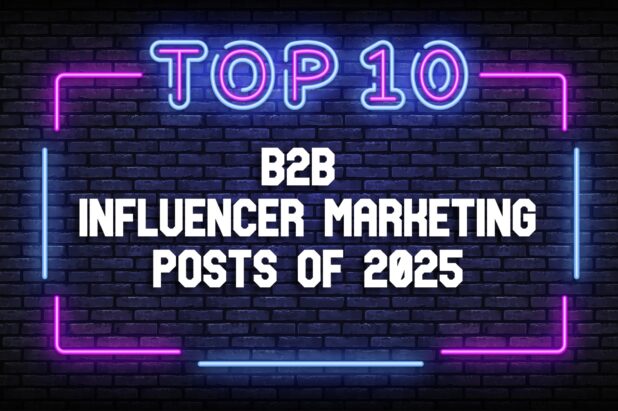As B2B marketers dealing with all new levels of uncertainty and expectation, we’re in a constant battle for trust and attention with the audiences we want to engage. So more than ever, B2B brands are investing in building relationships with industry experts and creators. as shown in our own research which found 85% of B2B marketers including influencer marketing in their mix.
But what if I told you that one of your most powerful, authentic, and scalable influence engines is already on your payroll?
I’m talking about your employees.
From internal subject matter experts to executives, most B2B brands are sitting on a goldmine of influence.
While partnerships with industry thought leaders and influencers are a cornerstone of an effective B2B marketing strategy, the thoughtful activation of employees as brand advocates is too often discounted or overlooked. Smart B2B marketers are strategic about looking outside for industry credibility while also looking inside to transform their workforce and leadership into a highly credible marketing channel that can drive results across the customer lifecycle.
The business case for building B2B influence from within
If you need to convince the leadership (or even yourself) at your B2B company to invest in a formal employee advocacy and executive influence program, we’ve already done the research and implemented such programs for B2B clients. The benefits of authentic internal advocacy can extend across brand, demand and even revenue generation, making it an incredibly impactful initiative.
The People Behind the Brand Create Trust and Engagement
In the B2B world, trust is a currency that is only increasing in value and marketers are definitely on board. Research from LinkedIn found 93.7% of marketers agree that building trust is the most important factor for achieving success as a B2B brand. And according to research from Forrester, over 90% of survey respondents say that buyers trust peers in their industry. This trust translates directly into engagement.
Further research from LinkedIn found that while only 3% of employees share content about their company, those shares are responsible for driving a 30% increase in the total engagement a company sees. When an employee shares a piece of B2B brand thought leadership, their network sees it as a credible insight from a knowledgeable peer, not an ad to be ignored. This kind of authentic context is critical for cutting through information overload – especially in an age of AI.
Employee Advocacy Delivers Cost-Effective Reach
Research from DSMN8 reports that 52% of companies surveyed say that brand awareness is the biggest benefit of employee advocacy and that 23% of companies engaged in employee advocacy programs are generating a cost-per-click of under $1 from employee shares. A program that builds employee advocacy and executive influence can provide a platform for substantial organic reach at a fraction of the cost of paid media.
Consider a mid-sized company with 200 employees. If each employee has an average of 500 connections on LinkedIn, the company’s potential collective reach is 100,000 individuals. That’s a network that probably surpasses the follower count of the official company LinkedIn page. Tapping into these extended networks allows your brand’s message to reach new audiences in a credible way.
Socially Engaged Staff and Sales Teams Create Direct Revenue Impact
The benefits of trust and reach can translate into tangible business outcomes. According to Hinge Research Institute, nearly 64% of advocates in a formal program credited employee advocacy with attracting and developing new business, and nearly 45% attribute new revenue streams to employee advocacy. Additionally, LinkedIn found that “Salespeople who regularly share are 45% more likely to exceed quota. Plus, leads developed through employee social marketing convert more frequently than others and socially engaged companies are 57% more likely to see increased sales leads.”
By empowering employees and executives to build their own professional brands and share valuable content, you can create a groundswell of positive sentiment and awareness that directly fuels the sales pipeline.
A B2B marketer’s framework for building influence and advocacy from within
Launching a successful employee advocacy and executive influence program requires a strategic framework that goes beyond simply asking employees to “like and share” company posts. It involves a deliberate effort to provide clear goals, actionable guidance, compelling content, and sustained motivation. Here is a basic framework for that:
Establish Clear Goals and KPIs: As with any B2B marketing effort, your internal advocacy and influence program must have defined objectives. Is the primary goal to increase brand awareness (measured by reach and impressions), generate qualified leads (measured by clicks and conversions from shared links), or boost employer branding to attract top talent (measured by engagement on career-related posts)? Setting these goals upfront is critical for measuring success and demonstrating ROI.
Provide Content and Clear Guidelines: In addition to key insights on the narratives and messaging most important to your ICP, the foundation of any advocacy or influence program is a steady stream of high-quality, relevant, and easily shareable content. This includes blog posts, case studies, social content, images, videos, and industry news. It is important to provide employee and executives with clear guidelines on social media policy with encouragement of personalization.
As you can imagine, the most effective employee posts are those where individuals add their own commentary and perspective, rather than simply copying and pasting boilerplate text.
Invest in Enablement and Technology: Not every employee is a social media rock star. Providing training on best practices for professional platforms like LinkedIn is an important step in building their confidence and competence.
Having worked in the B2B influencer marketing space for well over 10 years, we’ve had many instances where individuals were influential in their area of expertise, but not well-versed in the ways of “being” or behaving like an influencer when it comes to media or content creation and sharing. So, it is not uncommon for B2B brands to train employees and even executives on media creation and social platforms to help them become comfortable.
From a tool standpoint, an employee advocacy platform, such as Oktopost, Sprinklr, EveryoneSocial, GaggleAmp, Sociabble or DSMN8, can significantly increase participation. These tools simplify the process of finding and sharing approved content, track performance, and allow marketing teams to measure the program’s overall impact.
Inspire Motivation through Recognition and Leadership: Sustained, consistent and impactful participation requires motivation. Gamification elements like points and leaderboards can create healthy competition, while tangible incentives and public recognition show appreciation.
It can be important for leadership to lead by example. When senior executives actively participate and share content, employees are more likely to follow suit. Their involvement signals that advocacy is a valued and important activity. Additionally, executives will build their own influence and therefore the influence of the brand when they are active on social channels.
5 Types of B2B Content Your Employee Advocates Will Love to Share
To maximize engagement, the content you provide to employees and executives should be relevant and specific to the person, their audience and the channel in which the content is being shared. Based on best practices, here are five of the most effective types of shareable content:
- Behind-the-Scenes Content: Posts that showcase team collaboration, preparations for a product launch, or “day in the life” videos. This content humanizes the brand and makes it more relatable.
- Thought Leadership Commentary: Encourage your internal subject matter experts and executives to share their unique perspective on industry news or trends, positioning both them and the company as authorities.
- Customer Wins and Success Stories: Empower employees who worked on a successful project to share the case study from a personal perspective. Executives can share from a more strategic perspective.
- Event and Webinar Invitations: A personal invitation to a webinar from an employee who is speaking or involved can drive significantly higher registration rates than a generic corporate promotion.
- Company Milestones and Updates: Celebrate major achievements like funding rounds, strategic partnerships, or new feature launches. These posts keep your brand top-of-mind and project an image of momentum and success.
Employee advocacy can be a scalable and sustainable “always-on” influencer strategy for a B2B company. Maintaining continuous engagement with a large roster of external influencers can require robust resources that may not be present within the company. A well-run employee advocacy program can create a perpetual stream of authentic content from a credible and deeply knowledgeable source – your own employees and leaders. When both external and internal influence is developed the credibility, authority and trust that is developed is far more powerful than working with external influencers or an employee advocacy program on its own.
By investing in the right training, technology, and content, B2B marketers can tap into much desired authenticity and build an influence engine that supports the goals of marketing, sales, and human resources at the same time.
If you’d like to learn more about how to power-up your employee advocacy and executive influence program with industry influencers, let’s talk.



